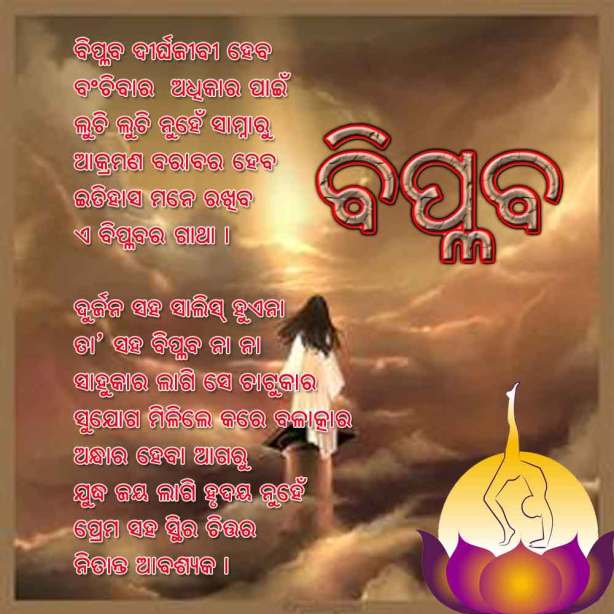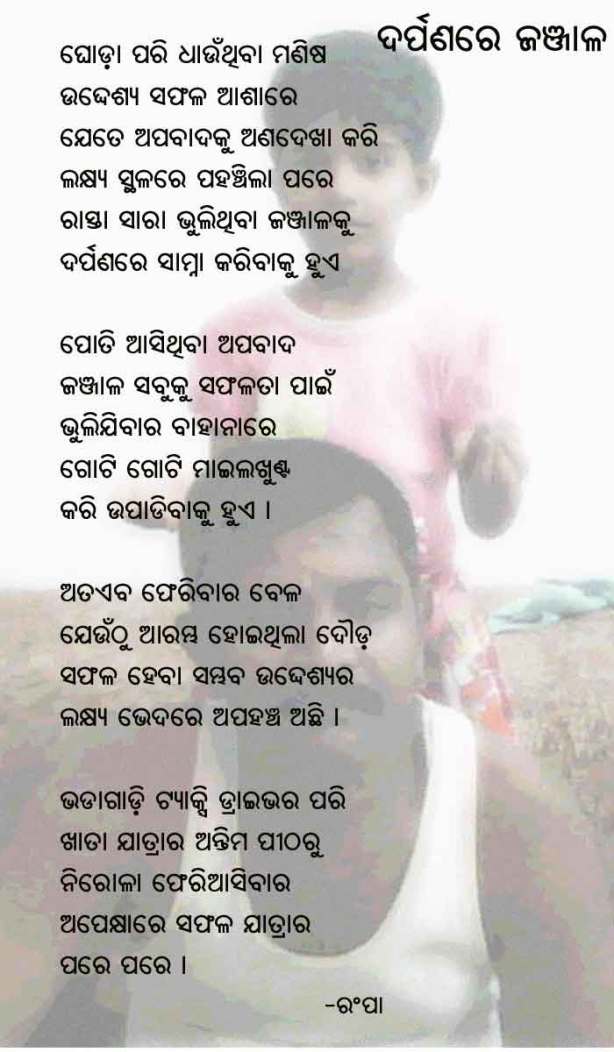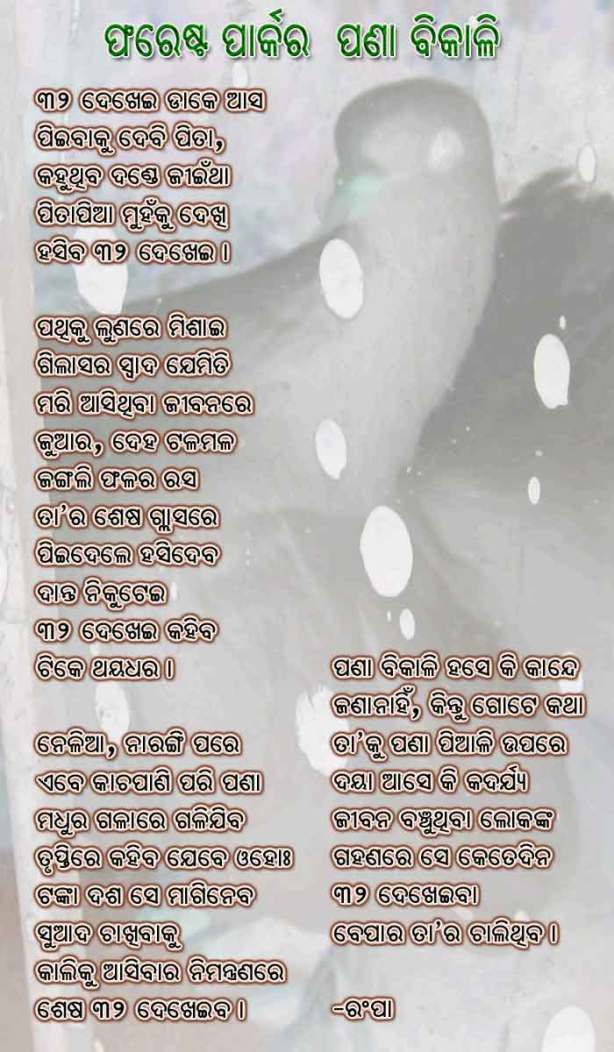sportslogon
Posted: July 15, 2012 in bhubanewar, cuttack, odisha site tour, odisha tour, osisha personality, UncategorizedTags: odisha sports, sports

Image
—
Posted: June 15, 2012 in Uncategorized
Tags: india, literature, odia, odisha, poetry
Daru Brahma
Posted: October 1, 2011 in bhubanewar, LORD JAGANNATH, odisha site tour, odisha tour, PURIDaru otherwise means wood. Brahma is the mystic expression of the Lord. It is the cosmic cause and comic result of the universe. It means ever expanding and endless. Thus Daru Brahma or Daru Devata is the supreme power of the Universe. We know Lord Jagannath and other three images seated on the Ratna Singhasan of Jagannath Temple are made of wood. The wood is not any ordinary wood; it is neemwood and neem-wood is also called Daru in the interior parts of Orissa.
The greatness of Darubramha has become lively in Sarala Mahabharata. Once being enraged, king Hiranya questioned his minor son Prahallad about the existence of Lord Vishnu. Prahallad trembling with fear indicated towards a pillar of the palace as his answer. Hearing the bold answer of Prahallad, Hiranyakashiapu with much cruelity and wrath hit the pillar by his sword. Immediately, Lord Vishnu emerged out of the pillar taking the form of a lion-headed human being and mitigated the sorrows of Prahallad.
The lion-headed God is named as God Narasingha, who is also regarded as the fourth incarnation of Lord Vishnu. In his invocation, Sharala Das has described God Narasingha as Shri Jagannath. Both Lord Shri Rama Chandra and Lord Shri Krishna Chandra are also named as Kodandadhari and Dandadhari. Thus, it indicates the relation of these Lords with Daru. In the Musali Parva of Oriya Mahabharat, it has been described that the hunter Jara scored an arrow to Lord Shrikrishna and the Lord breathed his last and merged with Lord Vishnu. Later, Jara and Arjuna, while started to perform the cremation of Lord Shrikrishna, they heard the heavenly voice, “set fire to my mortal remains using the log on which you would find the symbols conch, wheel, club and lotus. As per the direction, Arjun placed the body of Lord Shrikrishna on sandal wood and set fire. But the Pinda (heart) did not burn. During the event, Jara thought that Shrikrishna had earned sins during His life time and thus, the fire is unable to make His body to ashes.
While Jara was thinking deeply, again the Heavenly voice resounded, “This heart will not be gutted in fire. Immerse the body in the sea, it will be worshipped on the Neelasundar hill.” After alapse of long years, a Daru was seen floating on water on the confluence of river and Bay of Bengal at Banki – Muhan near Jagannath Dham, Puri. King Indradyumna and Savar Biswabasu brought the Daru to the shore. King Indradyumna, desirous of constructing idols of Lord sighted the sacred wood according to search made as per the command of the Lord Jagannath to King Indradyumna but wood could not be sized, and form of Lords could not be conceived. But one offered flower, from the head of the deity, Kakatpur Mangala, on advice of sage Narada, was taken and touched on the sacred wood, Daru Brahma. It facilitated the splitting of wood, into three parts for construction of idols Lord Jagannath, Subhadra and Balabhadra according to requirement.
Nabakalebara (construction of New idols of the three Lords) is regular feature of Jagannath Dham at regular intervals. Old, worn out idols are rejected and buried under earth and in their place, new idols for 3 deities, i.e. Lord Jagannath, Subhadra and Balaram, are constructed. From that time, tradition, still remains that carpenter sevaks and priests living with discipline pray, Maa Mangala of Kakatpur remaining prostrated before the deity at Kakatpur to bless them by showing sacred trees and their location, which alone are suitable for construction of the idols in Nabakalebara. In fact, they get the indication, and exact location of the sacred trees and path leading to the location, in dream. This practice and custom and tradition have been existing for years together, without any deviation. Successful guidance, without fail, from the deity to find out the sacred tree, is evidence of the power and energy of Maa Mangala of Kakatpur. This is unchallenged evidence which stands unrebutted giving concrete proof of blessing, power of mother Mangala on their devotees. Even Lord Jagannath who is the hood of all universe is assisted by mother, who is the original power for creation, is actively guiding the carpenters and priests to find out suitable sacred wood, according to specific features, for construction of the sacred idols, what to speak of other evidence.
Built in the 12th century, the temple of Lord Jagannath at Puri has the distinction of h a v i n g two u n i q u e p i l l a r s , n ame l y, t h e Garudastambha and the Arunastambha. In Sanskrit the pillar or a column is called a stambha and in Oriya it is called khamba. The objective of this paper i s to throw l ight on the significance and historical perspectives of the pillars.
Garudastambha
G a r u d a , i n I n d i a n t r a d i t i o n s i s considered as the vehicle of Vishnu. Lord Jagannatha is considered identical with Vishnu and Krishna. Hence his Vahan-stambha is placed in the nata-mandira of the temple. The
tradition of erecting pillars in honour of Vishnu goes back to 2nd century B.C. There is a pillar in honour of Vasudeva at Basnagar (Vidisha) in Madhya Pradesh. It is known from the inscriptions that “this Garuda column of
Vasudeva (Krishna), the God of Gods is erected here by Heliodorus, his worshipper.” He was an inhabitant of Taxila and he came as Greek A m b a s s a d o r f r o m k i n g A n t i a l k i d a s t o Kasiputra Bhagabhadra. It is thus evident that Heliodorous was a Vaishnava, even though he was a Greek. In Orissa with progress of Vaishnaism Vishnu temples were erected. The Nila Madhaba temple at Gandharadi of Boudh district in 9th century A.D. ruined Vishnu temple at Ganeshwarpur of Cuttack district in 10th century may be cited as notable examples. Jajpur, whi ch wa s prima r i ly a Shaktapitha dedicated to Viraja, also has numerous Vishnu images. In Jajpur t h e r e i s b e a u t i f u l column, which according to James Fergusson, originally seems to have supported a figure of Garuda, the vahana of Vishnu and a detached figure of Garuda is also found in Jajpur and it is said to be an identical one. Fergusson assigned the pillar to the 10th or 11th century. Thi s pi l l a r loc a l ly c a l l ed Subhas tambha indicates the existence of a Vishnu temple at Jajpur. The temple of Lord Jagannatha was constructed by Ananta Varman Chodagangadev in the middle of 12th century. The temple complex consists of Deula, Jagamohan, N a t ama n d i r a a n d B h o g ama n d a p a . T h e presiding deities on the Ratnabedi or Jewelled- dias are the Chaturdha-darumurthi i.e. wooden s t a t u e s s u c h a s B a l a b h a d r a , S u b h a d r a , Jagannatha and Sudarshan. The images are made out of the wood of the Neem Tree (Melia Azardicata). These are renewed every 1 2 y e a r s , t h e c e r emo n y b e i ng c a l l e d t h e Navakalebar. The Ratnavedi is said t o c o n t a i n
S a l a g r a m a o r ammonite fossils. It is taken to be a s t o n e a n d worshipped by the f o l l o w e r s o f V i s h n u .
Salagrama means the “village where the Sal tree (Shorea robusta) grows.” The Salagrama shilas are found in the bed of Gandaki River, a tributary of the Ganga. It is also found in the Narmada river.
In the Natamandira of the temple on the eastern side a unique Garuda stambha is located. In the first sight it looks like an ordinary stone column surmounted by a Garuda figure on the top. But on examination its shaft
seems to be a remnant of a plant of a past geological era. The shaft bears the impression or traces of a Sal tree shorn of its bark. The impression of the Sal tree is readily preserved. The total height of column along with the
pedestal and the Garuda capital is about 10 feet. The height of shaft is about 7 feet. The column is not made up of an ordinary stone but a Salagrama stone. It is the largest Salagrama stone, unique in the fossil record of India. This
Garudastambha, made up of fossil, is quite harmonious to the chaturdha-darumurthis on the ratnavedi made of salagrama stones. The erection of Garudastambha in Vishnu temples became quite popular in the Ganga
period following the model of Jagannatha temple. We find Garuda stambhas in later temples such as Madhavananda temple (13th century) at village Madhava in Cuttack district and Ananta Vasudeva Temple in 1278 A.D. at
Bhubaneswar. Inside the Jagannatha temple the Garudastambha is considered very holy and it has its own rituals and devotees usually have a darshan of the lord from this place. They used to place lamps in honour of Lord by which pillar becomes smoke stained. It will be worthwhile to discourage this practice.
Chhera Pahanra
Posted: October 1, 2011 in LORD JAGANNATH, odisha site tour, odisha tour, PURI, SHREE MANDIRChhera Pahanra is a ritual performed by the king of Odisha every year during the festival of rathayatra.This is an Odia word where “Chhera” is Sprinkling of holy water and “Panhara” is sweeping thus Chhera Panhara is sweeping of while sprinkling holy water.After the idols of the lords are installed on the chariots the king sweeps the chariots of lords with a golden broom.Then he worships lord by performing an aarati after which the holy journey starts.
This ritual is performed to show the devotion of the head of the state to the lord.It is a very old ritual .With time the ritual has changed.Earlier the king used to sweep the street before the chariots as it used to proceed but with time the ritual has changed and now the kings sweep the chariots only.
Well why this change has occured?There is an interesting story regarding this.It is said that years ago a King of Puri, Purusottama Dev, was to marry a princess who was the daughter of king, Maharaja Sallwo Narasingha, from the district of Kanchi. When the Ratha-Yatra festival was to take place, the father of the princess was invited.
But the king didn’t come instead he sent his minister . When he attended rathayatra, the King of Puri was performing Chhera Panhara.The minister, rather than being impressed with the devotion of the King for Lord Jagannatha, did not approve of him sweeping the road.
When he reported this to King Sallwo Narasingha, the king objected to the idea of his daughter marrying the King of Puri since he was merely a street sweeper. Purusottama Dev on learning this got angry and thought of teaching a lesson .So he attacked Kanchi. Unfortunately, King Purusottama Dev was badly defeated.
On his way back to Puri , he stopped at the cottage of Saikatacharya, a devotee of Lord Jagannatha. Saikatacharya pointed out that the King had forgotten to ask permission from Lord Jagannatha before he went to attack King Sallwo. With this realization, the King returned to Puri and visited the temple of the Lord. He spent the night in the temple, and with doors closed, before the night came to an end, the King heard a voice asking why he was so distraught over such a simple thing. The voice said to go gather his troupes again, and that we two brothers, Jagannatha and Balarama, would go along to fight on the King’s behalf. As the news spread, many people, both old and young, joined the King’s forces to fight with Their Lordships. However, as they went, the King was filled with some doubts if its going to be true or just an illusion.
While the King and his army went onward, far ahead were two soldiers that rode on one black horse and one white horse. They stopped to quench their thirst at a small village near Chilika Lake by buying some yogurt from a devotee named Manika. She offered them yogurt, but when she asked for money, they said they had no money. Instead they gave her a jeweled ring and told her to give it to King Purusottama Dev, who would then give her money.
After some time, the King caught up to the lady, who flagged him down to give him the ring and asked for money for the soldiers’ drink. The king was shocked to see the ratnamudrika ring of Lord Jagannatha and then regained his confidence that, indeed, Their Lordships had certainly come with him. In payment for the ring, the king gave her the whole village, which is still named Manikapatna. After this the king and his troupes were victorious over King Sallwo, and he also took King Sallwo’s daughter as well.
However, he did not marry her after the insult her father had given him. He instructed his minister to see that she got married to a qualified sweeper. After one year, at the next Ratha-Yatra, the King again performed his sweeping ceremony. At that time, the king’s minister announced that the king was the most qualified sweeper, since he swept for Lord Jagannatha, and that the princess, Padmavati, should marry him. Then Maharaja Purusottama Dev married the princess.At some point after this, the King of Puri discontinued sweeping the streets and now sweeps the carts.








